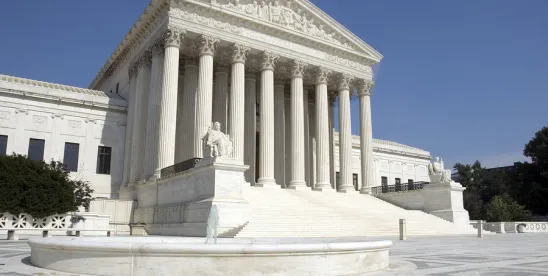All nine Supreme Court Justices heard argument on Wednesday, April 26, in Sandoz Inc., v. Amgen Inc. The Supreme Court is reviewing interpretations of the Biologics Price Competition and Innovation Act (“BPCIA”)[1] made by the U.S. Court of Appeals for the Federal Circuit.[2] Wednesday’s arguments focused on four main issues: (1) whether the Food and Drug Administration (“FDA”) could preliminarily grant licensure prior to the expiration of the 12 year statutory period; (2) whether the notice of commercial marketing requires official licensure to be made; (3) whether the “patent dance” [3] was required by the BPCIA; and (4) whether state law could be used to enforce compliance with the “patent dance” elements of the BPCIA. Industry watchers hope that the Supreme Court will streamline the process for getting biosimilars to market by providing increased certainty.
Background
The BPCIA, included in the Affordable Care Act, was intended to create an FDA approval pathway for generic versions of biologic drugs similar to the pathway provided by the Hatch-Waxman Act for small molecule drugs. The present controversy is based on Sandoz Inc. (“Sandoz”) seeking FDA approval for a generic version of Amgen’s filgrastim drug Neupogen under the BPCIA. At its heart, the controversy stems from the interpretation of the word “shall” and of a notice requirement in 42 U.S.C. § 262 (k) and (l).
A judge in the U.S. District Court for the Northern District of California ruled in Sandoz’s favor that (1) providing Amgen with a copy of its abbreviated Biologics License Application was not required under § 262(l)(2)(A), and (2) that Sandoz’s notice of commercial marketing provided to Amgen before the FDA had approved Sandoz’s application was sufficient notice under § 262(l)(8)(A).[4]
The Federal Circuit ruled that a biosimilar applicant must provide a notice of commercial marketing to the reference product sponsor (“sponsor”) after the biosimilar application is approved, and cannot market the biosimilar for 180 days after providing the notice. The Federal Circuit also ruled that a biosimilar applicant need not provide a copy of its application or manufacturing information to the sponsor under section 262(l)(2)(A), and engage in the “patent dance;” if the biosimilar applicant does not provide this information, the sponsor may only bring a patent infringement litigation or a declaratory judgment action.[5]
The Supreme Court granted Sandoz’s petition for a writ of certiorari[6] to address: (1) “whether notice of commercial marketing given before [U.S. Food and Drug Administration (“FDA”)] approval can be effective;” and (2) “whether, in any event, treating [42 U.S.C. § 262(l)(8)(A)] as a stand-alone requirement and creating an injunctive remedy that delays all biosimilars by 180 days after approval is improper.”[7] The Court also granted Amgen’s cross-petition to address (3) whether an applicant is required “to provide the [s]ponsor with a copy of its biologics license application and related manufacturing information” pursuant to 42 U.S.C. § 262(l)(2)(A) and where an applicant fails to provide such information, “is the [s]ponsor’s sole recourse to commence a declaratory judgment action . . . and/or patent-infringement action.”[8]
SCOTUS Arguments
During argument, the parties generally agreed that the FDA cannot approve a biologics license application for a biosimilar until the 12 year statutory period under the BPCIA has elapsed. However, Sandoz argued that FDA approval is not required before an applicant can provide the sponsor notice of commercial marketing under the BPCIA. Sandoz contended that FDA approval is not a prerequisite because biosimilars are close enough to their reference product that a general notice of intent to market a biosimilar provides a good-faith basis for alleging patent infringement and meets the statutory requirements for a lawsuit. In contrast, Amgen argued that infringement does not occur until an FDA license has been granted at the 12-year mark because the FDA may require changes to the biosimilar manufacturing process that affect whether a patent covers the biosimilar product or manufacturing process.
In addition, Amgen argued that the “patent dance” provisions of the BPCIA are mandatory. In contrast, Sandoz and the United States as amicus curiae contend (under differing theories) that information sharing is not mandatory because the BPCIA grants patent holders a cause of action to sue for declaratory judgment if any of the information sharing provisions are violated.
-
Timing of FDA Licensure
Sandoz and Amgen agreed that FDA licensure cannot be officially granted under the statute before the 12 year statutory time period has expired.[9] The parties disagreed, however, on whether the FDA can grant conditional approval of a biologics license application before the 12-year period expired. Sandoz asserted that the BPCIA does not allow the FDA to grant tentative approval of a biosimilar drug before the 12 year exclusivity period expires. Amgen argued that the FDA may grant a conditional license only effective after the 12 years have elapsed, but noted that the 12-year period had expired long ago in this case, and is not an issue here.
-
Timing of the Notice of Commercial Marketing
The parties contested whether the biosimilar applicant can serve the notice of commercial marketing only after FDA approval. Sandoz argued that notice can be provided as soon as an application to the FDA is filed, since application evinces an intent to market a product biosimilar to the sponsor’s reference product. Sandoz’s proposed interpretation avoids adding any time to the statutory 12 year exclusivity period. Justices Breyer, Roberts, Kagan, Kennedy, and Sotomayor each expressed incredulity that effective notice of commercial marketing could be given to a sponsor without final FDA approval. Those Justices noted that such a notice may not include the final manufacturing process, the final biosimilar product, or both. Sandoz responded that biosimilars are similar enough to sponsor products that a sponsor may always bring a good faith lawsuit alleging that the proposed biosimilar infringes the primary patents covering the sponsor’s drug. In addition, Sandoz argued that many steps in the “patent dance” are required to be performed in order, but the notice of commercial marketing is not, indicating that the notice may be given earlier in the process.
During argument, Justice Breyer, Chief Justice Roberts, and Justice Ginsburg each suggested that the timing of the notice need not be resolved now, and should be addressed after the FDA goes through the rulemaking process.
Amgen reasoned that the applicant must provide the notice of commercial marketing after approval because the 180-day period following the notice of commercial marketing is designed to focus patent litigation on the final, approved application for a biosimilar, and not an unapproved application that may change. Amgen argued that before final approval, there is no imminent harm of an impending biosimilar launch, so a district court would be unwilling to enjoin the marketing of a biosimilar. Amgen also argued that litigation occurring years before FDA approval of the biosimilar would likely result in another round of litigation after approval. The early litigation may be based on a manufacturing process or product that is vastly different from what the FDA actually approves, which might require a second round of litigation once the biosimilar nears approval. Moreover, Amgen argued that patent applications pending in the United States Patent and Trademark Office (“USPTO”) may issue after the initial round of litigation and require more litigation after approval.
-
Requirement of the “Patent Dance”
Sandoz and the United States argued that the “patent dance” is not required. Instead, it is one of two options under the BPCIA for initiating a patent litigation over a biosimilar. The other option is a declaratory judgment action by the sponsor.[10] The sponsor is incentivized to sue because if it does not, it will be unable to seek injunctive relief or any damages other than a reasonable royalty.[11] The biosimilar applicant is incentivized to participate in the “patent dance” to limit the scope of litigation before the litigation starts.
Amgen argued that the “patent dance” is required based on the plain meaning of the word “shall” as opposed to the word “may” also used in the statute, and that the “patent dance” is enforceable by injunction under state law.
Justices Kagan, Roberts, and Sotomayor expressed reservations about a ruling that the “patent dance” is optional because the result would be a lawsuit filed before the parties (and the district courts) know the precise scope of the alleged infringement.
-
State Law Preemption
Justices Gorsuch, Roberts, and Sotomayor asked questions about the preemption of state law. Sandoz argued that there is no state law issue on appeal since the only judgments are based on federal law and thus only the federal judgment is on appeal. The United States argued that because the “patent dance” is optional under the statute, opting out of the patent dance would not be a violation of federal law. Thus, a state law case to enforce the patent dance would be moot, since there can be no equitable state law remedy to enforce an optional federal law provision.
Amgen, in contrast, argued that the “patent dance” is mandatory, and therefore, it can be enforced under state law based on Bates v. Dow Agroscience.[12] Justices Sotomayor, Breyer, Roberts, and Gorsuch expressed reservations about allowing different states to apply their own, potentially differing rules to enforce the “patent dance” provisions.
Looking Forward
With multiple issues in front of the Court, it remains to be seen whether the Court will limit its decision to fewer than all of the issues presented, or will go out of its way to clarify the BPCIA. K&L Gates will continue to monitor this case and provide updates regarding developments.
[1] 42 U.S.C. § 262.
[2] Amgen Inc. v. Sandoz Inc., 794 F.3d 1347 (Fed. Cir. 2015), Amgen Inc. v. Apotex Inc., 827 F.3d 1052 (Fed. Cir. 2016), cert.denied, 137 S. Ct. 591 (2016) (holding that notice of commercial marketing and the subsequent 180 day waiting period can only be given after FDA licensure).
[3] Amgen Inc. v. Sandoz Inc., 794 F.3d at 1357. The “patent dance” is an exchange of patent information between the biosimilar applicant and the reference product sponsor.
[4] See Amgen Inc. v. Sandoz Inc., Case No. 14-cv-04741-RS, 2015 WL 1264756 (N.D. Cal. Mar. 19, 2015).
[5] Amgen Inc. v. Sandoz Inc., 794 F.3d at 1357-58 (majority opinion).
[6] Order List: 580 U.S., 2016 Term Court Orders, Supreme Court of the United States 1 (Jan. 13, 2017)
https://www.supremecourt.gov/orders/courtorders/011317zr_q8l1.pdf (granting certiorari and granting motion of Apotex, Inc. et al. for leave to file brief as amici curiae).
[7] Petition for Writ of Certiorari at ii, Sandoz Inc. v. Amgen Inc.,No. 15-1039 (Feb. 16, 2016).
[8] Conditional Cross-Petition for a Writ of Certiorari at ii, Amgen Inc. v. Sandoz Inc., No. 15-1195 (Mar. 21, 2016).
[9] Transcript of Oral Argument at 6, 37, Sandoz Inc. v. Amgen Inc., (Apr. 26, 2017) (No. 15-1039) and Amgen Inc. v. Sandoz Inc., (Apr. 26, 2017) (No. 15-1195), https://www.supremecourt.gov/oral_arguments/argument_transcripts/2016/15-1039_bqm1.pdf.
[10] 42 U.S.C. § 262(l)(9)(C).
[11] 35 U.S. Code § 271(e)(6)(B) (“In an action for infringement of a patent described in subparagraph (A), the sole and exclusive remedy that may be granted by a court, upon a finding that the making, using, offering to sell, selling, or importation into the United States of the biological product that is the subject of the action infringed the patent, shall be a reasonable royalty.”).
[12] Bates v. Dow Agrosciences LLC, 544 U.S. 431 (2005) (“Thus, although FIFRA does not provide a federal remedy to those injured as a result of a manufacture’s violation of FIFRA’s labeling requirements, nothing in §136v(b) precludes States from providing such a remedy.”).





 />i
/>i
